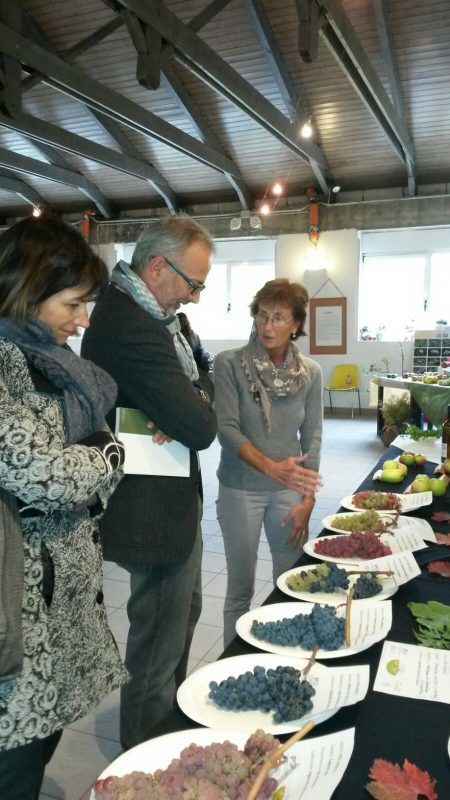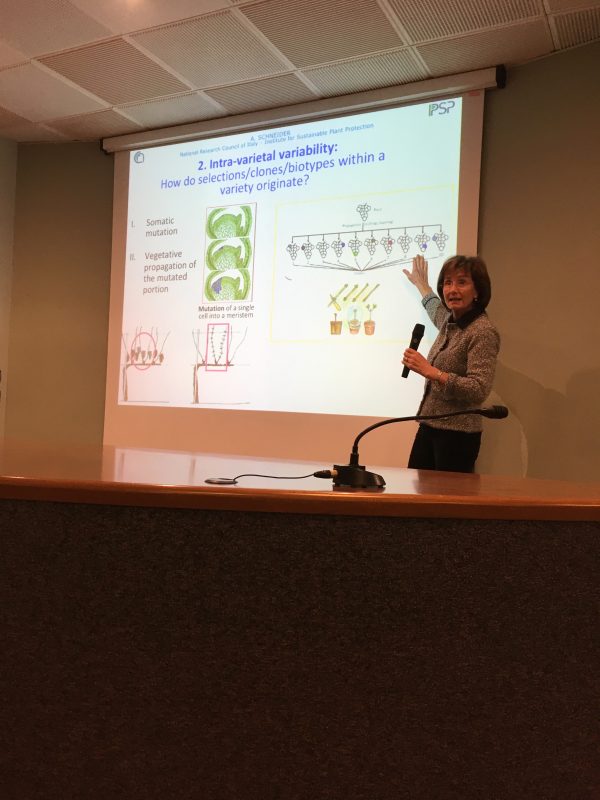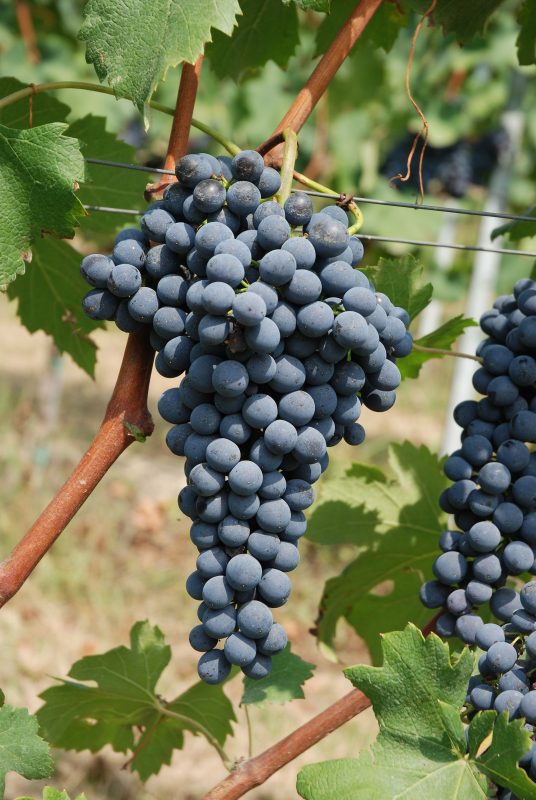This article originally appeared in the Spring 2022 print issue of Quench Magazine.
Dr. Anna Schneider likes plants.
She also loves the outdoors, and wine. Schneider is one of those lucky individuals who has managed to combine her passions into a successful and rewarding career. “I started to be, if you want to use that word, an ampelographer,” she says.
Considering she’s one of Italy’s foremost experts in the field of ampelography, which involves the identification and classification of grape vines, Schneider is also very modest. She has been a researcher at the National Research Council of Italy, and the Institute for Sustainable Plant Protection in Turin since 1982. During her career Schneider has verified the varietal identity of numerous vines, thus helping untangle the mystery of many obscure grapes – for example, that Liguria’s Rossese is one and the same as Tibouren in France; that Calabria’s Mantonico Bianco is distinct from Montonico Bianco, which is found in Abruzzo, Le Marche and Puglia; and that Corinto on the island of Lipari is a seed-less mutation of Sangiovese. The list goes on.
Born in the small city of Biella between Turin and Milan, Schneider grew up at the foot of Monte Rosa. Her father, like most of the area’s inhabitants, was employed by the local textile industry, but Schneider was more interested in food production and, above all, didn’t want to get stuck in an office.
“I always liked to be outside and was constantly observing what was around me – trees, plants, etc.” She studied agriculture at the University of Turin, focusing on botany, and graduated with a Masters in viticulture and oenology. Among her classmates was Aldo
Vaira, of Barolo producer G.D. Vajra. (The two were singled out as two of the most brilliant students.)
“At the time, ampelography wasn’t even taught at university,” Schneider notes. It was more art than a science until the late 1940s when Pierre Galet systematized the identification of grape vines by morphology – essentially features that can be observed by the naked eye. Identifi ers include the shape and contours of vines leaves, characteristics of the shoots, the shape and size of the grape bunches and colour, as well as size and seed content of the grapes. When ampelography courses were eventually introduced in the mid-80s, Schneider’s former viticulture professor asked if she would come back to teach them. “I didn’t know anything,” she claims – but agreed to the chal-lenge. “Because I was teaching it, I needed to learn it myself.” Moreover, she quickly fell in love with the course, in particular time spent in the vineyard distinguishing different vines.
In the ‘90s, the breakthrough of DNA analysis changed the field allowing for vine identification through genetic fingerprinting. While classic ampelography is based on morphology, Schneider considers molecular genetics just another (notable) element of ampelography. She starts from the idea that ampelography comes from the words ampelos and grapho. Ampelos is the vine and grapho means to write, but in Greek it also means describe. “So that means ‘a description of the vine’ – which can be done in various ways. For me it’s all one.”

Nebbiolo Rosé 
Nebbiolo
She explains that morphology works in tandem with DNA analysis. “If you are a good ampelographer in the field, you are able to reduce the amount of work in the lab.” Accurate identification of collected samples helps avoid errors such as mistaking a Pinot Blanc vine as a clone of Chardonnay – which has certainly happened. Schneider also points out that morphology is the only way to categorize ancient varieties, as the plant material no longer exists for DNA testing.
Conversely, molecular genetics can provide information about the relationship among grape varieties. “This is something that a morphologist can perceive by intuition perhaps, but they can’t demonstrate definitely,” Schneider says. The pioneering study was in 1996 Nebbiolo when American grape geneticist Carole Meredith verified Sauvignon Blanc and Cabernet Franc as parents of Cabernet Sauvignon. Since then, Schneider has also been involved in mapping out complex family trees.
She compares the process to a paternity test for humans. “Half of our genetics come from our father and the other half from our mother. If I analyse the genetic profile of a child, according to probability statistics, there could only be two parents that have the genetic patrimony compatible to give that child.” It is the same with vines. However, if a parent grape vine is extinct or has yet to be analysed, parentage is difficult to determine. Such is the case with Nebbiolo, for example.
This work inevitably requires many hours in the lab. So, while Schneider doesn’t work in an office per se, she does spend a lot of time in front of the computer. Nevertheless, she still finds it stimulating. “To think that a five century-old variety comes from varieties that existed even before it,” she exclaims. “Like Riesling, which is the child of Gouais Blanc.” While the latter barely exists today, it was once widespread. “The Romans would have passed by Gouais when they crossed through the Balkans,” Schneider muses.
In terms of practical applications, she argues that understanding the genetic structure of varieties helps determine which parents could bequeath interesting characteristics. “The more we study how those characteristics are inherited, the more information we have about obtaining those characters in an off-spring.”
Finally, she points to the marketing aspect. “There is nothing like telling a story, a tidbit to captivate wine lovers.” Especially when it is factual.
Nevertheless, some discoveries have awkward implications. For example, Nebbiolo Rosé was long thought to be a subvariety of Nebbiolo (along with Michet and Lampia). However, in 2000, Schneider and her colleagues discovered that the two are genetically distinct. Soon after, they determined that Nebbiolo and Nebbiolo Rosé are siblings.
While there is nothing sinister about this finding, it does call into question the regulations for Barolo and Barbaresco which state that these wines must be made from 100% Nebbiolo. Schneider believes that it is best to let sleeping dogs lie. “Nebbiolo Rosé is very much a part of the existence of Nebbiolo. They have always been found together. It makes sense to leave it in the mix.” Furthermore, relatively few plantings of Nebbiolo Rosé actually exist.
Schneider’s work has been a true labour of love. Many of the parentage studies have had no financing. “I was able to do this work thanks to bits of money and time from other work that was financed,” she explains.
Clearly it is worth it to Schneider, and she has certainly discovered many fascinating and unexpected relationships. One of these is the connection between Riesling Italico aka Welschriesling (which has no relationship with Riesling) and Barbera. They have one parent in common but the other parent of each is not yet known. “I would like to determine if Welschriesling, which is widely disseminated in the Balkans, actually has Italian origins,” she says.
Herein lies the conundrum of her work. “It never ends because when you understand one thing you realize there is still so much more to understand.”
Alas, as of 2022, Schneider has officially retired from all her various teaching positions. Besides spending 34 years teaching Ampelography at the University of Turin she was a guest lecturer for Vinifera’s International Master of Science in Viticulture and Enology. “Soon I will be 70,” she discloses. “I didn’t want to be like an old mussel that has become permanently encrusted on the rocks.” No doubt she will be missed by her students. At every lecture I’ve attended, the audience hangs on to her every word.
But retirement for Schneider is active; when I caught up with her, she was on her way to Nebbiolo Prima in Alba. At this annual event, which showcases the newest releases from Barolo, Barbaresco and Roero, she usually regales journalists with a seminar on her latest findings of Nebbiolo’s intricate family tree. This year she was bringing with her an experimental bottling of Pignolo Spano – another sibling of Nebbiolo, which her group determined is identical to Pignola Valtellinese. “It has certain aspects that are similar to Nebbiolo,” she describes. “And like Nebbiolo it will need time to evolve.”
Schneider’s ardour of vines is undoubtedly matched by her enthusiasm for wine. “My interest in food was born from wine,” she asserts. “I enjoyed drinking wine with my dad from the time I was old enough.” Always with a meal, of course. Unsurprisingly she selects by grape variety rather than region or terroir.

“I like trying wines that are a bit peculiar – often minor grapes that we don’t normally talk about but might have genetic or historical importance for whatever reason.” She admits that not all taste good, but two that she is particularly fond of are Swiss grape Petite Arvine and French grape Chatus. The latter, by the way, she determined is the same as Piedmont’s Nebbiolo di Dronero.
Among northwest Italy’s better-known grapes, she singles out Barbera for everyday drinking. “I like the acidity, the colour. It can also be fruity with soft fine tannins.” As for international grapes, Schneider prefers Syrah to Cabernet Sauvignon, citing the former’s supple tannins, roundness, and complexity of aromas. “If I go to a restaurant, I never order a Chardonnay, Cabernet Sauvignon or Merlot. I always try to find something a bit curious or local,” she adds. And if it’s a special occasion she veers toward Barolo. “It gives you different and new emotions.”
Every sip, like every step she has taken in her life, serves to satisfy Schneider’s insatiable curiosity.

Michaela Morris is an international wine writer, educator and speaker based in Vancouver, Canada. She has worked in various capacities of the industry for 25 years. Besides holding the Wine & Spirit Education Trust Diploma, Michaela is an Italian Wine Expert certified through Vinitaly International Academy (VIA) and leads seminars on Italian wine around the globe. Not surprisingly, her go-to cocktail is a negroni.


